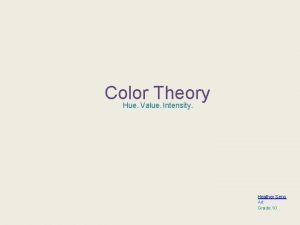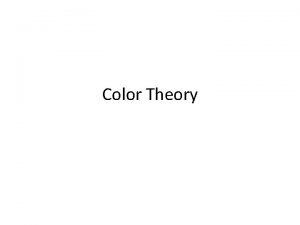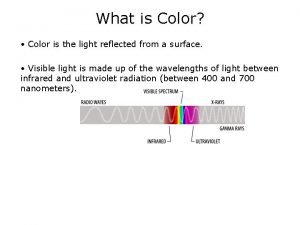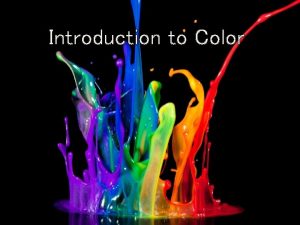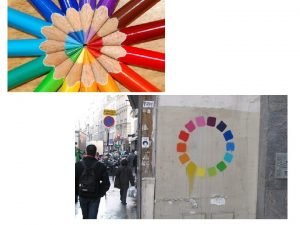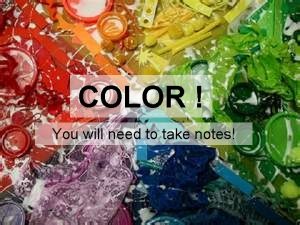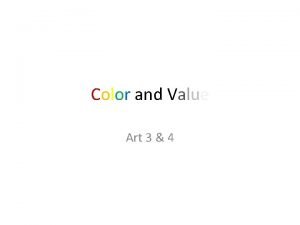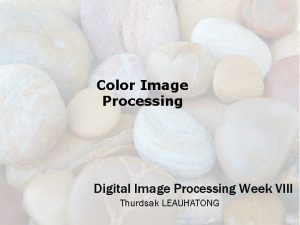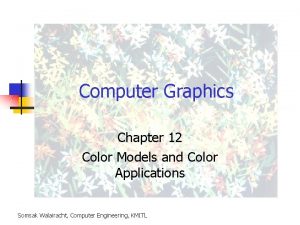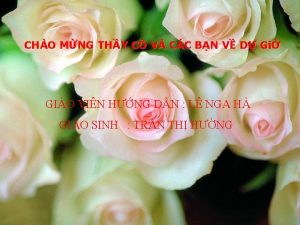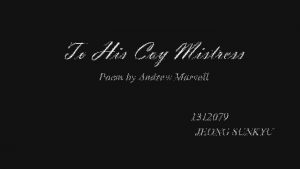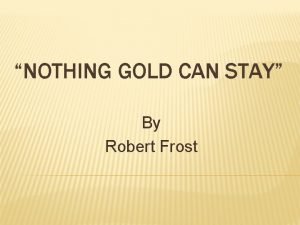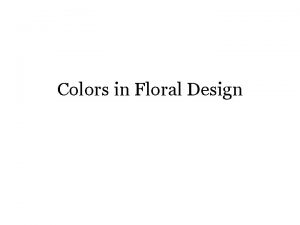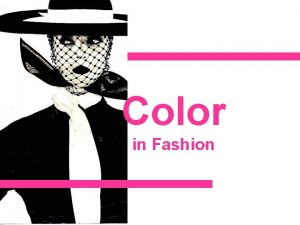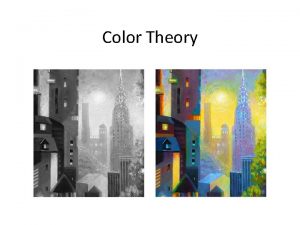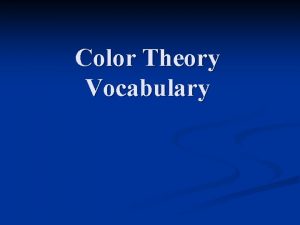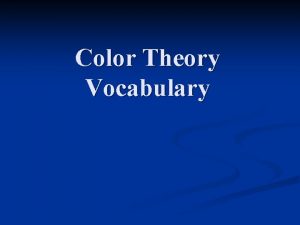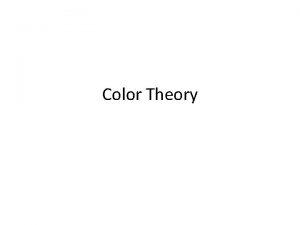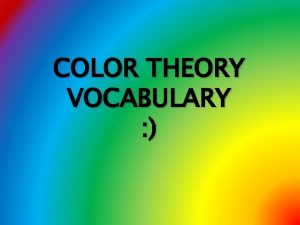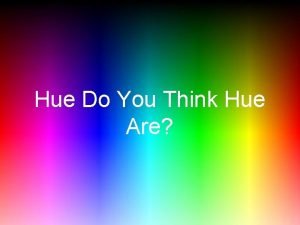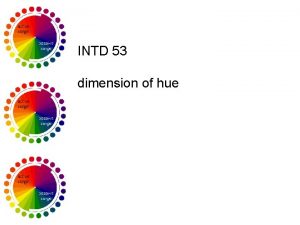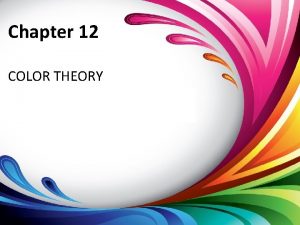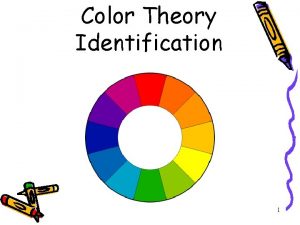Color Theory Hue Value Intensity Heather Seno Art



















- Slides: 19

Color Theory Hue. Value. Intensity. Heather Seno Art Grade 10

“Color is my day-long obsession, joy & torment. ” -Monet

Color Fundamentals: how we see color Color is the most expressive element of art. Color is derived from reflected light. White light from the sun is actually a combination of all colors. Color spectrum is bands of color created when light passes through a prism. Colors of the spectrum always appear in the same order: red orange yellow green blue violet A rainbow is a natural example of a spectrum. We see color because objects absorb some light waves and reflect others. Receptors in our eyes detect the color of reflected light waves. Other receptors detects the lightness & darkness of the color. Three properties work together to make the colors we see These properties are: Hue. Value. Intensity.

Click to view Bill Nye – Light & Color

Bill Nye – Light and Color: Applying Your New Knowledge In your groups, answer the following questions on your handout. Then check your answers. 1. When white light goes into a _____ prism , it breaks up into all the spectrum of colors of the rainbow or the full _____ 2. All of the colors of the rainbow are red, yellow, green, blue, _______ indigo and violet. These colors _____ be broken up. cannot 3. An object ____ reflects the color that it is showing while _____ absorbing all of the other colors in the spectrum. 4. We don’t see things, we see ______ light bouncing off of things. 5. Paint has particles in it called ____. pigment These particles absorb all other colors and ____ reflect the colors they are showing. 6. ______ White reflects all colors.

Hue: The name of a color in the color spectrum.

Primary Hue: Pure colors Red Blue Yellow You cannot make primary hues by mixing other hues together By combining the three primary colors with black & white, You can produce every other color.

Secondary Hue: Made by mixing primary colors Orange Green Red + Yellow = Orange Violet Blue + Yellow = Green Red + Blue = Violet

by mixing a primary color Intermediate Hue: Made with secondary color (aka Tertiary Hue) Red-Orange Red-Violet Red + Orange = Red-Orange Blue-Violet etc. Blue + Violet = Blue-Violet etc.

The More “Hue” Know! In your groups, answer the following questions on your handout. Then check your answers. 1. The name of a color in the spectrum is a _____. hue 2. Secondary Hues are _____, orange _____ green & violet. 3. By combining ______ primary colors with black or white, you can make any other color. intermediate hue. 4. The hue red-orange would be considered a(n) ______ 5. The three types of hues are _______, primary secondary ______ & ______. intermediate

Color In Motion! Follow the link. Go through the “Stars” door, pick a secondary color & answer the questions on the following slide.

Color In Motion! After following the link on the previous slide. Get in your groups & answer the questions on this slide about a secondary color. 1. What is your color? 2. Which primary colors mix to create your color? 3. What color compliments the color you’ve chosen? 4. List 5 (total) positive & negative traits that your color represents. 5. Name one “Around the World” fact about your color. 6. Using both of the primary colors within your color, answer questions 1, 3, 4 & 5.

Value: The art element that describes the darkness or lightness of a color. The amount of light a color reflects determines its color value. Not all hues of the spectrum have the same value. Yellow is the lightest hue because it reflects the most light. Violet is the darkest hue because it reflects the least light. Black white & gray are neutral colors. When a white light shines on a white object, the object reflects all of the color waves and does not absorb any. As a result, you see the color of all the light, which is white. A black object absorbs all of the color waves. Black reflects no light; black is the absence of light. Gray is impure white - it reflects an equal part of each color wave. The more light that gray reflects, the lighter it looks; the more it absorbs, the darker it looks.

Interactive Color Wheel With your group, go to this site & answer the questions on the following slide.

Interactive Color Wheel 1. On the website provided, pick one of the primary colors & fill out the following information: Temperature: Compliment: Analogous Colors: Split Compliments: Psychological Effects: 2. Choose an intermediate (or tertiary) color, leave the cursor on the color & answer the following questions: What is the color triad? What is the color tetrad? 3. List the warm colors. 4. List the cool colors.

Intensity: The brightness or dullness of a hue. If a surface reflects only yellow light waves, you see an intensely bright yellow. If a surface reflects other light waves, the color will appear duller. A pure or bright hue is called a high intensity color. Dull hues are called low intensity. Complementary colors are the colors opposite each other on the color wheel. The compliment, or opposite, of a hue absorbs all of the light waves that the hue reflects. Red & Green are compliments. Green absorbs red waves & reflects blue & yellow waves (blue & yellow waves combine to make green). Mixing a hue with its compliment dulls the hue, or lowers its intensity. . The more compliment you add to a hue, the duller the hue looks. With too much compliment, the color turns a neutral gray. The hue used in the greatest amount in a mixture becomes dominant. This could lead a mixture to appear dull orange or dull blue. Orange & blue mixtures yield brownish results.

Hue. Value. Intensity. Rely on one another to create every color we see. By carefully observing colors, you will see dull tints & bright tints, dull shades & bright shades, light hues & dark hues. Knowing the three properties of color helps you to understand & use color.

On Your Own: Homework Assignment In the hand out provided, answer the following questions relating to today’s lesson: What are three properties of color? Define color wheel. What does the color wheel show? Name three components of color. What are complimentary colors? How do complementary colors affect each other? Pick a product in your house & describe the colors used to represent that product. Why do you think these colors were used? Vocabulary To Know: Color Spectrum Hue Tint Intensity Complimentary Colors

Works Cited Brock, Elizabeth. (Producer). (1993). Bill Nye The Science Guy. Available from http: //www. youtube. com/watch? v=gtg. BHs. Sz. CPE&feature=related Cortes, M. (2010). Color In Motion. Maria. Claudia. Cortes. Retrieved February 20, 2012 from http: //www. mariaclaudiacortes. com/colors/Colors. html Fussell, M. (2010). The Interactive Color Wheel. The Virtual Instructor. Retrieved February 20, 2012 from http: //thevirtualinstructor. com/interactivecolorwheel. html Monet (Painter). (1920). Reflections of Clouds on the Water-Lily Pond [Painting], Retrieved February 22, 2012 from: URL (http: //en. wikipedia. org/wiki /File: WLA_moma_Claude_Monet_Reflections_of_Clouds_on_the_Water-Lily_Pond. jpg) The Color Wheel. (2008). The Paint Basket. Retrieved February 22, 2012 from http: //www. paintbasket. com/tools/color_wheel. php
 Color in motion maria claudia cortes
Color in motion maria claudia cortes Hue value for red
Hue value for red Chroma hue value
Chroma hue value Altered color wheel
Altered color wheel Color wheel tint tone shade
Color wheel tint tone shade Contoh value creation
Contoh value creation What are the 5 primary colors
What are the 5 primary colors Color intensity scale
Color intensity scale Color level
Color level Color complements in image processing
Color complements in image processing Hue massacre
Hue massacre Hsv color model in computer graphics
Hsv color model in computer graphics Ptbđ ca huế trên sông hương
Ptbđ ca huế trên sông hương Jacquemiers sign
Jacquemiers sign Youthful hue
Youthful hue What is the metaphor in nothing gold can stay
What is the metaphor in nothing gold can stay Her hardest hue to hold figurative language
Her hardest hue to hold figurative language Hue janice
Hue janice What is this color called
What is this color called Hue is the name of
Hue is the name of
